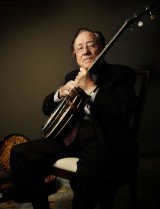
Earl Scruggs
In American history over the last century, many people point with clear memories about historic events. Folks can tell you how well they remember where they were when Pearl Harbor was bombed, when JFK was assassinated, and when the first reports of 9/11 came over the airwaves. For banjo players today, most of them can tell you where they were and how they felt the first time they heard Earl Scruggs play the banjo.
Scruggs, who died on March 28 at the age of 88, was known, not just as an instrumentalist with amazing talent. He was a true force with the instrument and the style of music he helped to define: bluegrass.
If Bill Monroe is thought of as the father of bluegrass, Earl Scruggs defined it and broadened its parameters into popular culture in ways that Monroe never dreamed possible. Earl Scruggs reinvented how the banjo was played and perceived within the music. Before Scruggs, the banjo was thought to be limited to certain ways of playing. Scruggs proved this to be wildly wrong.
Scruggs first appeared on the Grand Ole Opry stage in 1945 with Bill Monroe and the Blue Grass Boys. When he presented a near perfected three-finger syncopated style that other banjos had been working to master, he became a permanent member of Monroe’s band. When Bill Monroe first auditioned the then 21-year-old Scruggs, he admitted that he heard the final piece of the sound he had been working to create for many years. The three-finger banjo style of picking became popularized by Scruggs who played with Bill Monroe for three years. George Hays of the Grand Ole Opry referred to Earl Scruggs as “the boy who taught the banjo how to talk.” The band Scruggs completed at the time, which included guitar, mandolin, upright bass, fiddle, and Scruggs-style banjo, became and remained the gold standard for bluegrass bands. Today many bluegrass players still spend years trying to come close to what Monroe, Scruggs, and the Blue Grass Boys created live and in the studio during the three years they were together. There are constant arguments regarding the purity of bluegrass music and in keeping to the bluegrass tradition. However, in the beginning bluegrass was not created out of tradition but from innovation. Throughout his 57-year career this is the only tradition that Scruggs ever seemed intent on keeping.
In 1948, with the help of his business-savvy wife, Louise, who became his manager, Scruggs joined with Lester Flatt to form a new band. The union brought Nashville its first female manager in Louise Scruggs and solidified a collaborative duo that would effectively bring bluegrass and country music more popularity in the mainstream of popular music than had been known before.
In 1955, Flatt and Scruggs joined the Grand Ole Opry and debuted a television show. They scored hits with “Roll in my Sweet Baby’s Arms,” and “Foggy Mountain Top.”
As the folk music boom of the late ’50s and early ’60s was born, Scruggs continued to broaden the audience for bluegrass music and his unique style of banjo playing by appearing at the Newport Folk Festival. To the chagrin of many of the traditionalists of the musical form, including founding father, Bill Monroe, it wasn’t unusual to find Earl Scruggs jamming with sax players, drums, and electric guitars. With this came increased dates at colleges and universities.
By 1962 Flatt and Scruggs would become household names when they recorded the theme song for the popular television show, “The Beverly Hillbillies.” The song went to #1 on the country charts. This gave bluegrass and Earl Scruggs a kind of national exposure that would literally change lives and alter the course of country music for years to come.
“‘The Beverly Hillbillies’ came on, and I was just shaken to the core by the sound of Earl Scruggs’ banjo,” reflected legendary banjo player Bela Fleck. “I had no connection to the South, to bluegrass music, or to the banjo, but that sound just changed me.”
Flatt and Scruggs disbanded when Earl decided to work with his son’s country-rock band, which would eventually, become known as the Earl Scruggs Revue. The band gave Scruggs a chance to work closely with his sons and allowed his banjo to breathe life into new songs and styles. The band inspired the sound of the Nitty Gritty Dirt Band as they brought in other innovators like Vassar Clements on fiddle. They also collaborated with popular musicians of the time, including Linda Rondstandt, Arlo Guthrie, and Joan Baez.
But, it was in 1972, when, with the Nitty Gritty Dirt Band, Scruggs brought together traditional country musicians like Maybelle Carter and Roy Acuff with younger musicians to create the now classic, Will the Circle Be Unbroken. This album has become one of the handful templates that served to support a new genre of music called Americana. It’s become a style that embodies the attitude that Earl Scruggs came to symbolize. After Flatt and Scruggs were inducted into the Country Music Hall of Fame in 1985, Scruggs continued to tour and record as a bluegrass elder statesman.
He most recently toured in 2011 using a chair on stage while he continued to cause jaws to drop with his signature three-finger style banjo playing.
But, despite all of his accomplishments, inspiring generations of musicians, the feeling of loss in Nashville during his memorial at the Ryman Auditorium, the site of the original Grand Ole Opry and the place where he first met Bill Monroe and his wife Louise, was tangible. He was a master.
Dwight Worden is off this month but will return in June

